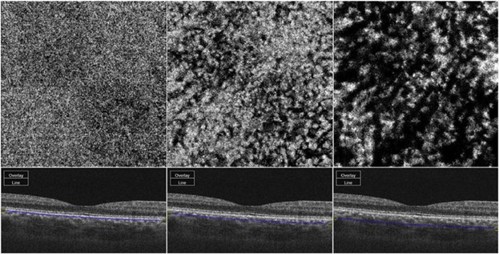This article was originally published in a sponsored newsletter.
Recent developments in retinal disease research were presented at the 2024 Association for Research in Vision and Ophthalmology (ARVO) meeting. Today’s research may one day provide preventions, treatments and even cures for people affected by age-related macular degeneration (AMD). This month, we will concentrate on studies that may lead to new therapeutic targets.
The Role of Choroidal Vessels
Irene Santiago Tierno, MS, from Dr. Kaustabh Ghosh's lab discussed how abnormal sub-endothelial matrix exacerbates choroidal endothelial cell death in early AMD. In this stage, the choroid’s vascular endothelial cells are mechanically abnormal. Abnormalities in the stiffness of both the cells and the matrix that they secrete may lead to their own death. This process can contribute to the pathogenesis of early AMD, eventually leading to severe dry or neovascular AMD (nAMD).1
Using atomic force microscopy, a technology that measures the stiffness in endothelial cells and the sub-endothelial matrix, the investigators analyzed choroidal endothelial cells from rhesus monkey eyes that developed early AMD. Understanding the mechanisms of how these endothelial cells die could offer potential future therapeutic targets (see Figure 1).1
Stem Cell Therapy Remains Promising
Regenerative Patch Technologies, a company developing stem-cell-derived treatments for people with retinal diseases, has reported encouraging results for the first five patients with advanced dry AMD participating in a Phase 1/2a clinical trial for its therapy: a patch comprised of a layer of retinal pigment epithelial (RPE) cells on a synthetic scaffold. One patient in the trial had a visual acuity improvement of 17 letters (about three lines) in her treated eye. Three patients maintained vision in their treated eyes, and two had improved fixation. No evidence of safety issues with the treatment was observed.
Luxa Biotechnology has announced the transplantation of RPE stem-cell-derived RPE (RPESC-RPE-4W) in the first participant of its Phase 1/2 clinical trial for people with dry AMD. Rajesh Rao, MD, the trial’s principal investigator at the Kellogg Eye Center, University of Michigan, transplanted 50,000 RPESC-RPE-4W cells under the macula of a legally blind participant with dry AMD. The 18-participant trial starting in Ann Arbor, Michigan, is the first in-human study of RPESC-RPE-4W for the treatment of a retinal disease. The RPESC-RPE-4W cell product is derived from adult human RPE stem cells that haven’t matured.
Mitochondrial Maintenance
Deborah A. Ferrington, PhD, of Doheny Eye Institute, presented on mitochrondrial changes with overall health and in diseased retinas. Mitochondria are the power center of the cell, and retinal cells are heavy in energy dependence. Mitochondrial maintenance, therefore, is critical for proper retinal function.
Dr. Ferrington presented results from a protein analysis of RPEs in human donors with and without AMD. The team found that the amount and quality of the mitochondria are significantly reduced in AMD. Dramatic changes were observed in mitochondrial proteins over the course of AMD progression, indicating that this may be a good therapeutic target.2 The next step is to dig deeper into what proteins are involved to see whether there are specific pathways that could suggest targeting.

References:
- Tierno IS, Agarwal M, Chandrakumar S, Ghosh K. Abnormal subendothelial matrix exacerbates choroidal endothelial cell death in early age-related macular degeneration. Invest Ophthalmol Vis Sci. 2024 June;65(7):2105-2105
- Ferrington DA. Genotype-specific differences in mitochondrial function specific to the CFH Y402H risk allele associated with AMD. Invest Ophthalmol Vis Sci. 2024 June;65(7):6468.




